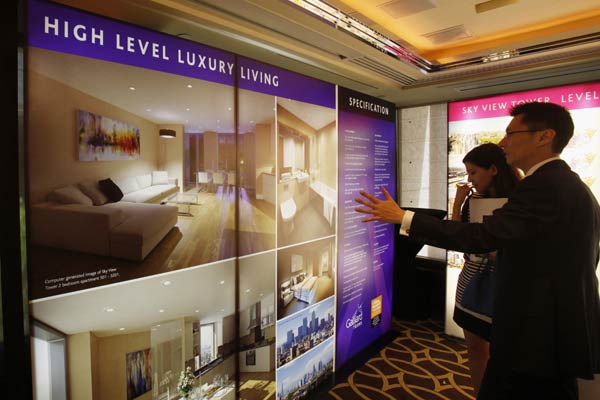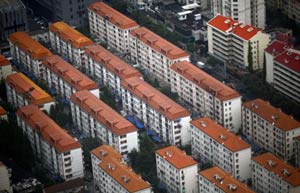 |
|
A salesman shows a visitor photographs of a London upmarket property development at a luxury hotel in Hong Kong. London's commercial property market has welcomed Chinese investors. REUTERS |
Investors should realize owning a famous building is no substitute for steady rents
London property is widely seen as an ideal and profitable investment, but Chinese companies also need to pay attention to the potential risks.
The city's commercial property market has welcomed Chinese investors. The latest large real-estate deal was made by China Life Insurance Co, the country's largest insurer, which was part of a consortium that bought 10 Upper Bank Street, a 32-story building in high-end business district Canary Wharf, for 795 million pounds ($1.35 billion) in June.
The deal was announced by Songbird Estates Plc, parent company of Canary Wharf Group. China Life has a 70 percent stake in the building.
Chinese companies' big investments have been in the spotlight over the past two years. But after the deals are done, the main risks lie in retaining long-term tenants and operating the properties.
 |
In this context, vacancies are an investor's worst enemy. Plenty of owners are struggling to find suitable, stable tenants for vacant space or whose current tenants are considering a move.
Another insurance giant, Ping An Insurance (Group) Co of China, knows this only too well. Ping An bought the landmark City of London headquarters of the Lloyd's insurance market for 261 million pounds last year, becoming the first Chinese insurer to buy a property in Britain.
It has been reported that Lloyd's is considering a move out of the building. According to sources, the insurer has been tired of the high cost of the site and has the option to leave in 2021. Lloyd's pays nearly 17 million pounds in annual rent, but service charges are twice as high as buildings elsewhere in the City, the financial district.
Losing a tenant means a yield of zero percent. If the owner also has a loan, the situation is even worse. Concern is growing as the building could be left vacant if Lloyd's moves out. It will not be easy for Ping An to find another tenant for the London landmark.
The case is a lesson: Buying a London building cannot guarantee steady rent flows or price appreciation. The tenants, the quality of the property, lease profiles and location should all be carefully assessed.
The China Life-led consortium's acquisition was financed by a loan of about 440 million pounds. Law firm Clifford Chance LLP is the sole office tenant in 10 Upper Bank Street on a 14-year lease, with the retail unit let to HCA International Ltd, the world's largest private hospital group. The annual rent on the building is 44.35 million pounds.
How to retain the primary tenant in a building and attract more tenants is always a question mark for a Chinese investor.
Another potential risk is from the Bank of England. The central bank cut interest rates to a record low level after the global financial crisis, but analysts increasingly believe the BOE will hike rates, given that the economy seems to be on the right track. Higher interest rates mean heavier burdens for all property owners.
Another high-profile City of London building, 30 St Mary Axe (informally known as the Gherkin), has been put up for sale by administrators who hope to attract bids of at least 650 million pounds.
The 41-story landmark building sits at the heart of the city. It was designed for insurance firm Swiss Reinsurance Co Ltd and opened in 2004. It fell into receivership this year after debts secured against the building soared. It is said that a Chinese company is interested in buying it.
Only the market knows whether it is any good time to buy the tower. But a Chinese company that buys it must make sure that the yield is high and sustainable.
